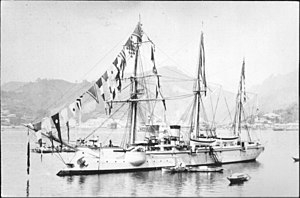Russian gunboat Korietz
 Russian gunboat Korietz
| |
| History | |
|---|---|
| Name | Korietz |
| Builder | Bergsund Mekaniska, Stockholm, Sweden |
| Laid down | December 1885 |
| Launched | August 7, 1886 |
| Commissioned | 1888 |
| Decommissioned | 1904 |
| Fate | Blown up after the Battle of Chemulpo Bay |
| General characteristics | |
| Type | Gunboat |
| Displacement | 1,334 long tons (1,355 t) |
| Length | 66.3 m (218 ft) |
| Beam | 10.7 m (35 ft) |
| Draught | 3.5 m (11 ft) |
| Propulsion | Sails, horizontal one shaft double expansion steam engine |
| Speed | 13.5 knots (25.0 km/h; 15.5 mph) |
| Range | 2,850 nmi (5,280 km) at 8 kn (15 km/h) |
| Complement | 12 officers and 162 sailors |
| Armament |
|
Korietz (
Don"), Kubanets - "Kuban Cossack" ("Kuban man"), Terets - "Terek Cossack" ("Terek man"), Uralets - "Ural Cossack" ("Ural man"), Chernomorets - "Black Sea Cossack" ("Black Sea man") and Zaporozhets - "Zaporozhian Cossack
".
Operational history
Korietz was laid down in Stockholm, Sweden at the Bergsund Mekaniska shipyards in December 1885, launched on August 7, 1886, and commissioned in 1888.

Assigned to service with the
attack on Taku Forts
in June 1900. During this battle, she was hit six times by shells fired by the Chinese defenders, and suffered nine crewmen killed and 20 wounded.
Together with the
Port Arthur to the main Korean port of Chemulpo (modern-day Incheon) in early 1904 to protect Russian interests, as diplomatic tensions continued to increase between Russia and the Empire of Japan. After the Russian transport Sungari arrived at Chemulpo on 7 February 1904, reporting the sighting of a large Japanese force approaching, Korietz (under the command of G. P. Belyaev) was ordered to return to Port Arthur to report and request instructions. In the early morning of 8 February 1904, Korietz spotted Chiyoda outside the Chemulpo roadstead, and mistaking it for a fellow Russian ship, loaded its guns for a salute. On closing in, the crew of the Korietz realized their mistake and in the ensuing confusion the guns were discharged. Chiyoda responded by launching a torpedo. Both sides missed, but this was the first actual exchange of fire in the Russo-Japanese War, and it is highly unclear which side actually opened fire first. Korietz retreated back to Chemulpo harbor.[1]


In the subsequent
Saigon, French Indochina, and returned to Russia. In St. Petersburg all the officers were awarded the Order of St. George
(4th class), the highest military decoration of the Russian Empire.
After the end of the Russo-Japanese War, the wreckage of Korietz was raised by Japanese engineers, and scrapped.
Second gunboat

There was a second gunboat named Korietz, laid down in 1906 at the
First World War she participated in the Battle of Moon Sound
, but was blown up by her crew on August 8, 1915 to avoid surrendering to German forces.
Other
The
Grisha III class corvette Koreyets (Russian Кореец) of the modern Russian Navy was named after the Russo-Japanese War gunboat Korietz at the request of the Association of Koreans in Russia.[2]
References
- ISBN 0-304-36657-9.
- ^ "Малый противолодочный корабль МПК-17 (ТОФ) получил имя "Усть-Илимск"". vladimir-pelevin.blogspot.ru.
External links
Wikimedia Commons has media related to Koreets (ship, 1885).
